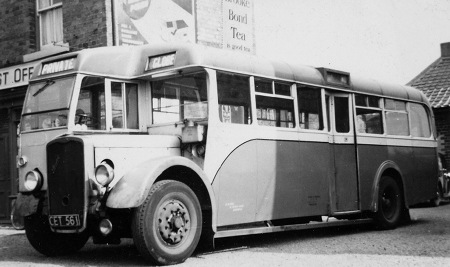
Photograph by “unknown” if you took this photo please go to the copyright page.
Rotherham Corporation
1941
Bristol L5G
East Lancs B32C
Here’s a nice old one, probable one of the oldest buses in my collection.
I obviously didn’t take this picture as the bus was withdrawn in 1957 I did not start taking bus photos till 1965.
This bus has a center entrance, can somebody tell me what advantage there was in having a center entrance. They would have to lose two pairs of seats to make way for the entrance but then they could put in a 5 seat bench seat at the back of the bus so they gain one seat. But if the only gain is one seat was it worth it. Another query I have which maybe you can help me with is what is the purpose of the box under the front window on the opposite side to the cab it looks as if it contains oil could it be an automatic oiling system or something.
A full list of Bristol codes can be seen here.
The box on the nearside, below the saloon window in an “Autovac” they were used on early Leyland and Bristol half cabs. They were to do with the braking system I believe.
Paul Ellender
Re the “Autovac” query this is a form of fuel supply, the square tank holding a reservoir of fuel drawn up from the main tank by vacuum.
Trevor Haigh
Many vehicles in this area were of the centre entrance configuration, in addition to several batches of Bristols Rotherham also had centre entrance single deck trolleybuses as did Mexborough and Swinton (who ran jointly with Rotherham on some routes).
West Riding had large numbers of centre door Regent double decks on Wakefield routes.
The advantage of this layout was quicker boarding and alighting times with both ends of the bus able to leave at the same time.
It should be remembered that this was long before a large scale move to one man operation and the necessary front entrance position so these buses were conductor operated.
The last similar vehicles were withdrawn by Rotherham in the late ’60s. There were some withdrawn ones there at the same time that their first Fleetline chassis were delivered before despatch to Roe
Andrew
Darlington Corporation had centre-entrance single-deck Guy Arabs right through the ’60s and before that, centre-entrance S/D trolley buses. Sunderland Corporation and, I believe, Hartlepool, too, had centre-entrance double-deckers.
Bill Taylor
Leeds had centre entrance saloons in the Fifties on underfloor engined chassis they had 2 Tiger Cubs 2 Guy Arab LUFs and 5 Reliances all with Roe bodywork seating 34 + up to 20 standees. They had the steepest steps I’ve ever seen on a bus. The stair well was inside the bus with the doors flush with the side panelling
Chris Hough
The Leeds vehicles were regarded as an experiment and were built on a mix of AEC Reliance, Leyland Tiger Cub and Guy Arab UF chassis. Three of the vehicles survive in a scrapyard – if you google ‘the wakefield files’ you’ll find them.
Andrew
Grimsby Corporation had quite a number of centre-entrance AEC/Roe double-deckers in the 1930s, as well as a unique fleet of ten 6-wheel AEC/Roe centre-entrance trolleybuses. They also had one of the very few AEC “Q” double-deckers with a Roe centre-entrance body, built in 1933 and still running in 1956. Since the engine was at the side, under the central staircase, there were lower deck seats beside the driver. I remember seeing this vehicle in service.
The biggest disadvantage of the centre-entrance design was the split staircase which took up a lot of space on the top deck, giving fewer seats on the top deck than the bottom. “Provincial Bus and Tram Album” by J. Joyce (1968) shows a 1931 Grimsby example as having only 48 seats, while the “Q” is listed as having 56 seats (H29/27C); the side engine didn’t take up passenger space.
Wakey Models makes resin kits of several variants of this type of vehicle, which can be seen at:
Editor’s note: The link now appears to be dead, but was:-
http://www.drcollectables.co.uk/index.php/cName/wakey-models
Martin S
The centre-entrance layout was greatly favoured by the Rotherham general manager who was in charge of the municipal transport department for many years, the redoubtable Tom Percy Sykes.
The bus shown in the picture happens to be one of the wartime Bristol chassis that was fitted with a post-war body removed from one of nine Bristol L6B’s that were rebodied as double-deckers not long after being delivered as 32-seat centre-entrance saloons. In the photo, although still in Rotherham livery, the bus is in second-owner service; I don’t have the information directly in front of me, but believe this was one of several similar ex-Rotherham single-deckers that ended their lives with Cosy Coaches, an independent operating in Meadowfield, County Durham. The blinds it is fitted with in the picture are not Rotherham ones, and the legal lettering on the nearside is not that of Rotherham Corporation.
Dave Careless
Leave a Reply